问题描述:使用逻辑回归(logistic regression)和神经网络(neural networks)识别手写的阿拉伯数字(0-9)
一、逻辑回归实现:
数据加载到octave中,如下图所示:
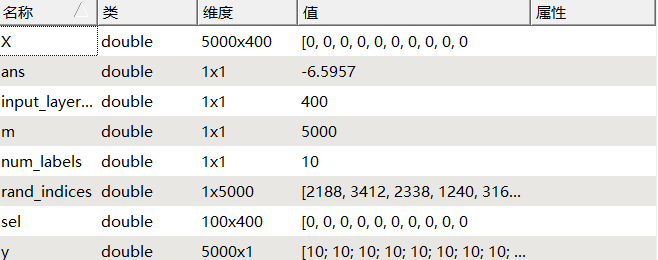
①样本数据的可视化
随机选择100个样本数据,使用Octave可视化的结果如下:
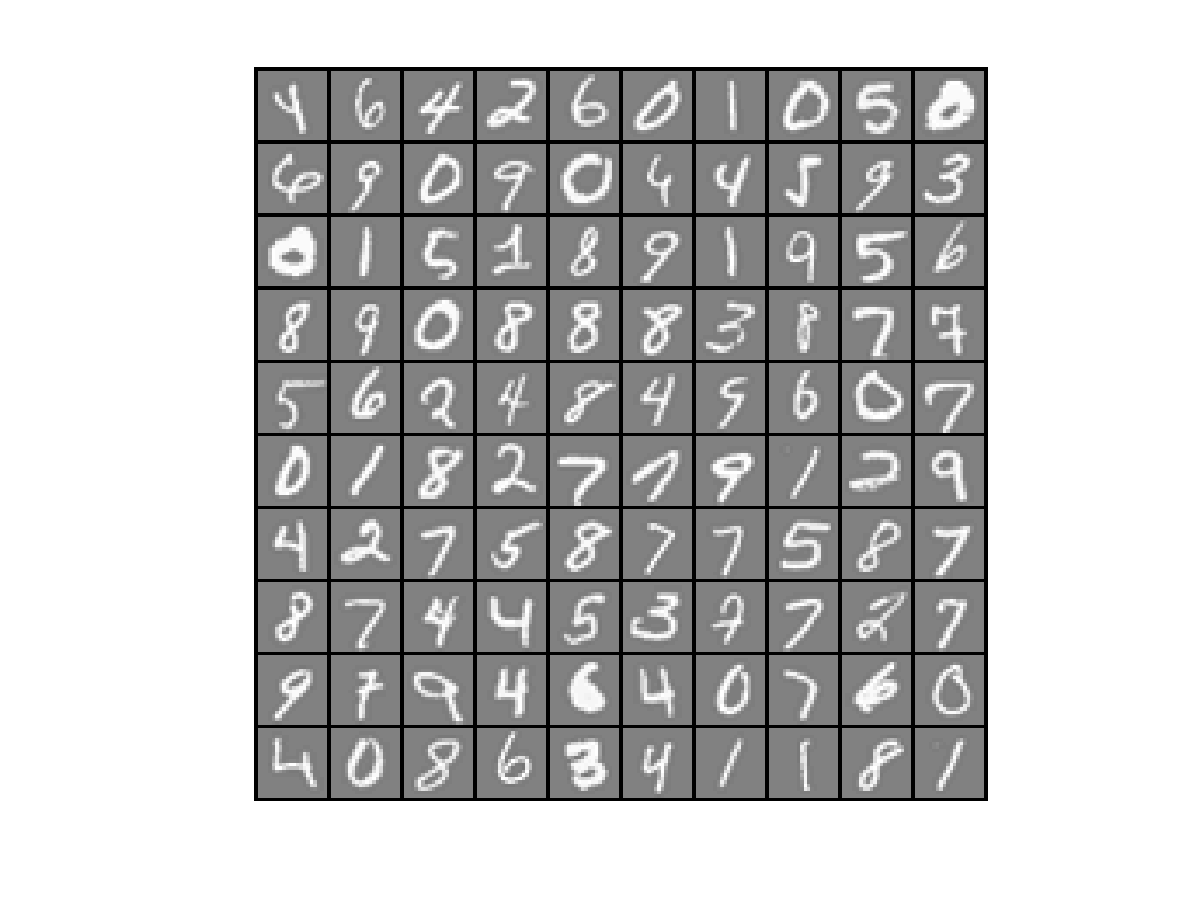
②使用逻辑回归来实现多分类问题(one-vs-all)
所谓多分类问题,是指分类的结果为三类以上。比如,预测明天的天气结果为三类:晴(用y==1表示)、阴(用y==2表示)、雨(用y==3表示)
分类的思想,其实与逻辑回归分类(默认是指二分类,binary classification)很相似,对“晴天”进行分类时,将另外两类(阴天和下雨)视为一类:(非晴天),这样,就把一个多分类问题转化成了二分类问题。示意图如下:(图中的圆圈 表示:不属于某一类的 所有其他类)
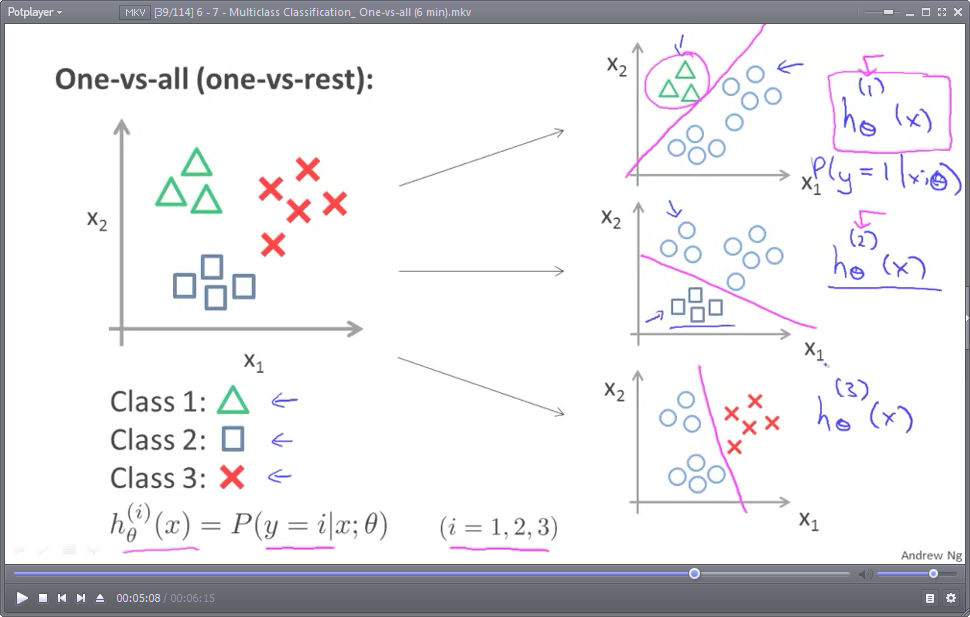
对于N分类问题(N>=3),就需要N个假设函数(预测模型),也即需要N组模型参数θ(θ一般是一个向量)
然后,对于每个样本实例,依次使用每个模型预测输出,选取输出值最大的那组模型所对应的预测结果作为最终结果。
因为模型的输出值,在sigmoid函数作用下,其实是一个概率值。,注意:hθ(1)(x),hθ(2)(x),hθ(3)(x)三组 模型参数θ 一般是不同的。比如:
hθ(1)(x),输出 预测为晴天(y==1)的概率
hθ(2)(x),输出 预测为阴天(y==2)的概率
hθ(3)(x),输出 预测为雨天(y==3)的概率
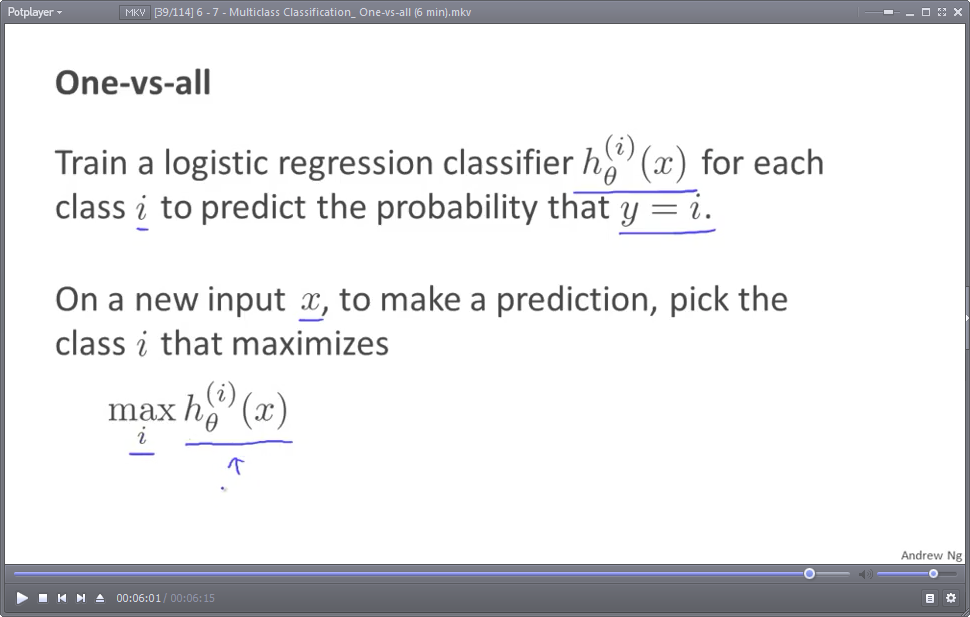
③Octave代码实现
对于上面的识别阿拉伯数字的问题,一共需要训练出10个逻辑回归模型,每个逻辑回归模型对应着识别其中一个数字。
我们一共有5000个样本,样本的预测结果值就是:y=(1,2,3,4,5,6,7,8,9,10),其中 10 代表 数字0
我们使用fmincg库函数 来求解使得代价函数取最小值的 模型参数θ
function [all_theta] = oneVsAll(X, y, num_labels, lambda)
%ONEVSALL trains multiple logistic regression classifiers and returns all
%the classifiers in a matrix all_theta, where the i-th row of all_theta
%corresponds to the classifier for label i
% [all_theta] = ONEVSALL(X, y, num_labels, lambda) trains num_labels
% logistic regression classifiers and returns each of these classifiers
% in a matrix all_theta, where the i-th row of all_theta corresponds
% to the classifier for label i
% Some useful variables
m = size(X, 1);
n = size(X, 2);
% You need to return the following variables correctly
all_theta = zeros(num_labels, n + 1);
% Add ones to the X data matrix
X = [ones(m, 1) X];
% ====================== YOUR CODE HERE ======================
% Instructions: You should complete the following code to train num_labels
% logistic regression classifiers with regularization
% parameter lambda.
%
% Hint: theta(:) will return a column vector.
%
% Hint: You can use y == c to obtain a vector of 1's and 0's that tell you
% whether the ground truth is true/false for this class.
%
% Note: For this assignment, we recommend using fmincg to optimize the cost
% function. It is okay to use a for-loop (for c = 1:num_labels) to
% loop over the different classes.
%
% fmincg works similarly to fminunc, but is more efficient when we
% are dealing with large number of parameters.
%
% Example Code for fmincg:
%
% % Set Initial theta
% initial_theta = zeros(n + 1, 1);
%
% % Set options for fminunc
% options = optimset('GradObj', 'on', 'MaxIter', 50);
%
% % Run fmincg to obtain the optimal theta
% % This function will return theta and the cost
% [theta] = ...
% fmincg (@(t)(lrCostFunction(t, X, (y == c), lambda)), ...
% initial_theta, options);
%
initial_theta = zeros(n + 1, 1);
options = optimset('GradObj','on','MaxIter',50);
for c = 1:num_labels %num_labels 为逻辑回归训练器的个数,num of logistic regression classifiers
all_theta(c, :) = fmincg(@(t)(lrCostFunction(t, X, (y == c),lambda)), initial_theta,options );
end
% =========================================================================
end
function [J, grad] = lrCostFunction(theta, X, y, lambda) %LRCOSTFUNCTION Compute cost and gradient for logistic regression with %regularization % J = LRCOSTFUNCTION(theta, X, y, lambda) computes the cost of using % theta as the parameter for regularized logistic regression and the % gradient of the cost w.r.t. to the parameters. % Initialize some useful values m = length(y); % number of training examples % You need to return the following variables correctly J = 0; grad = zeros(size(theta)); % ====================== YOUR CODE HERE ====================== % Instructions: Compute the cost of a particular choice of theta. % You should set J to the cost. % Compute the partial derivatives and set grad to the partial % derivatives of the cost w.r.t. each parameter in theta % % Hint: The computation of the cost function and gradients can be % efficiently vectorized. For example, consider the computation % % sigmoid(X * theta) % % Each row of the resulting matrix will contain the value of the % prediction for that example. You can make use of this to vectorize % the cost function and gradient computations. % % Hint: When computing the gradient of the regularized cost function, % there're many possible vectorized solutions, but one solution % looks like: % grad = (unregularized gradient for logistic regression) % temp = theta; % temp(1) = 0; % because we don't add anything for j = 0 % grad = grad + YOUR_CODE_HERE (using the temp variable) % J = ( log( sigmoid(theta'*X') ) * y + log( 1-sigmoid(theta'*X') ) * (1 - y) )/(-m) + (lambda / (2*m)) * ( ( theta( 2:length(theta) ) )' * theta(2:length(theta)) ); grad = ( X' * ( sigmoid(X*theta)-y ) )/m + ( lambda / m ) * ( [0; ones( length(theta) - 1 , 1 )].*theta ); % ============================================================= grad = grad(:); end
下面来解释一下 for循环:
num_labels 为分类器个数,共10个,每个分类器(模型)用来识别10个数字中的某一个。
我们一共有5000个样本,每个样本有400中特征变量,因此:模型参数θ 向量有401个元素。
initial_theta = zeros(n + 1, 1); % 模型参数θ的初始值(n == 400)
all_theta是一个10*401的矩阵,每一行存储着一个分类器(模型)的模型参数θ 向量,执行上面for循环,就调用fmincg库函数 求出了 所有模型的参数θ 向量了。
求出了每个模型的参数向量θ,就可以用 训练好的模型来识别数字了。对于一个给定的数字输入(400个 feature variables) input instance,每个模型的假设函数hθ(i)(x) 输出一个值(i = 1,2,...10)。取这10个值中最大值那个值,作为最终的识别结果。比如g(hθ(8)(x))==0.96 比其它所有的 g(hθ(i)(x)) (i = 1,2,...10,但 i 不等于8) 都大,则识别的结果为 数字 8
function p = predictOneVsAll(all_theta, X) %PREDICT Predict the label for a trained one-vs-all classifier. The labels %are in the range 1..K, where K = size(all_theta, 1). % p = PREDICTONEVSALL(all_theta, X) will return a vector of predictions % for each example in the matrix X. Note that X contains the examples in % rows. all_theta is a matrix where the i-th row is a trained logistic % regression theta vector for the i-th class. You should set p to a vector % of values from 1..K (e.g., p = [1; 3; 1; 2] predicts classes 1, 3, 1, 2 % for 4 examples) m = size(X, 1); num_labels = size(all_theta, 1); % You need to return the following variables correctly p = zeros(size(X, 1), 1); % Add ones to the X data matrix X = [ones(m, 1) X]; % ====================== YOUR CODE HERE ====================== % Instructions: Complete the following code to make predictions using % your learned logistic regression parameters (one-vs-all). % You should set p to a vector of predictions (from 1 to % num_labels). % % Hint: This code can be done all vectorized using the max function. % In particular, the max function can also return the index of the % max element, for more information see 'help max'. If your examples % are in rows, then, you can use max(A, [], 2) to obtain the max % for each row. % [~,p] = max( X * all_theta',[],2); % 求矩阵(X*all_theta')每行的最大值,p 记录矩阵每行的最大值的索引 % ========================================================================= end
二、神经网络实现
由于逻辑回归是线性分类(它的假设函数是一个线性函数,就是划一条直线,把数据分成了两类。
对于一些复杂的类别,逻辑回归就解决不了了。比如下面这个图片中的分类。(无法通过 划直线 将 叉叉 和 圆圈 分开)
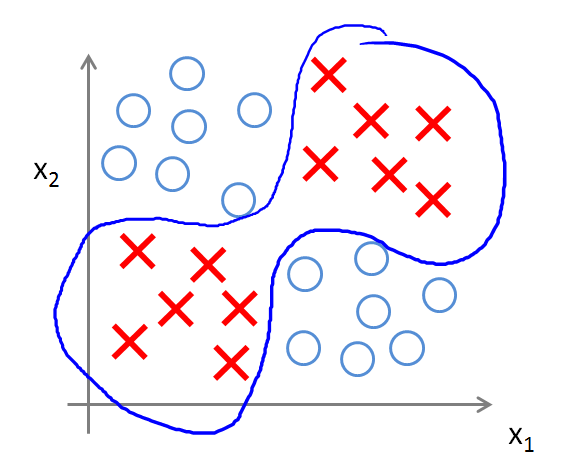
而神经网络,则能够实现很复杂的非线性分类问题。
对于神经网络而言,同样有一个训练样本矩阵 X,同时还有一个模型参数 Theta 矩阵,通过某种算法将 模型参数矩阵 训练好之后(求出 Theta 矩阵),再使用前向传播算法( feedforward propagation algorithm)(感觉就像是矩阵相乘嘛), 就可以对输入的测试样本进行预测了。
本作业中, 模型参数 Theta 矩阵是已经训练好了的,直接 load 即可。如下所示:

function p = predict(Theta1, Theta2, X) %PREDICT Predict the label of an input given a trained neural network % p = PREDICT(Theta1, Theta2, X) outputs the predicted label of X given the % trained weights of a neural network (Theta1, Theta2) % Useful values m = size(X, 1); num_labels = size(Theta2, 1); % You need to return the following variables correctly p = zeros(size(X, 1), 1); % ====================== YOUR CODE HERE ====================== % Instructions: Complete the following code to make predictions using % your learned neural network. You should set p to a % vector containing labels between 1 to num_labels. % % Hint: The max function might come in useful. In particular, the max % function can also return the index of the max element, for more % information see 'help max'. If your examples are in rows, then, you % can use max(A, [], 2) to obtain the max for each row. % % 模拟实现前向传播算法 X = [ones(m, 1) X]; a_super_2 = sigmoid(Theta1 * X'); a_super_2 = [ones(1,m); a_super_2];% add bias unit a_super_3 = sigmoid(Theta2 * a_super_2); %================================== [~,p] = max( a_super_3' ,[], 2 ); % 对样本的结果进行预测,与逻辑回归的预测类似,选取输出的最大值 作为最终的预测结果 % ========================================================================= end
注意:我们正是通过 max 函数,求得矩阵 a_super3′ 的每一行的最大值。将每一行的中的最大值 的索引 赋值给向量p。其中,a_super3′ 是一个5000行乘10列的矩阵
向量p就是预测的结果向量。而由于 a_super3′ 有10列,故 p 中每个元素的取值范围为[1,10],即分别代表了数字 0-9(其中10 表示 0)
测试代码如下:
rp = randperm(m);
>>
>> for i = 1:m
% Display
fprintf('
Displaying Example Image
');
displayData(X(rp(i), :));
pred = predict(Theta1, Theta2, X(rp(i),:));
fprintf('
Neural Network Prediction: %d (digit %d)
', pred, mod(pred, 10));
% Pause with quit option
s = input('Paused - press enter to continue, q to exit:','s');
if s == 'q'
break
end
end
例如下图所示的数字:

